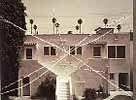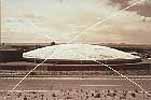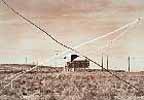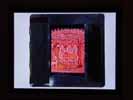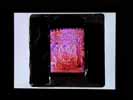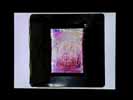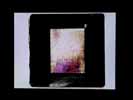Fiona McLaughlin
Fiona McLaughlin’s untitled video proposes an almost clinical scenario in which, like Dean, an impersonal, pre-programmed process appears to be at work. The “experiment” is both destructive and transformative for the photographic transparencies that are its object. McLaughlin, a Toronto artist and recent graduate of the Ontario College of Art and Design, uses discarded slides from her former school’s slide library as fodder for her work. She places the slides on a light table, tightly cropped within the video frame. For the first several seconds, we see an image that has been copied from an undocumented art history text. Then, we see a clear liquid (bleach) being dropped onto the transparency’s surface. For a second or two, the image remains intact, the drops of liquid pooling on its surface. Then, explosively, as the dyes that make up the slide’s colours run in all directions, the image transforms before our eyes from an art historical masterpiece, such as a Byzantine mosaic, into something that resembles an abstract expressionist painting.
The kind of uneasiness that accompanies the destruction of family photographs by Max Dean’s robot echoes in McLaughlin’s dissolution of images of well-known artworks. Her scenarios have the power to disturb and, yet, enthrall. Even though we recognize that we are viewing copies of an original artwork, our imaginations summon the destruction of the original (as actually happens in times of barbarity, such as war). And, yet, the dissolution process creates abstract images of great beauty in themselves. The price of that beauty is the forgetting of that which precedes it.
McLaughlin’s alchemical laboratory also references the ongoing transformation of the time-honoured tradition of the slide lecture, the staple of her recent art school experience. “Smart” classrooms wired for digital projection, the proliferation of laptop computers and the convenience of presentation software, such as PowerPoint, have combined to increasingly usurp the role of the 35mm film transparency in art education. Digital image databases for teaching use (complete with looming copyright issues) are now under construction. In spite of the many benefits arising from the digital formatting of presentations, there remains one significant drawback – the attainable resolution of the projected digital image is decidedly inferior to what it is replacing. At the present moment, data projectors cannot match the clarity of a projected 35mm slide. In this sense, the technology performs an “edit” on its subject through the very act of presentation.
|
